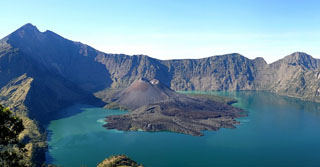Report on Rinjani (Indonesia) — October 1995
Bulletin of the Global Volcanism Network, vol. 20, no. 10 (October 1995)
Managing Editor: Richard Wunderman.
Rinjani (Indonesia) Small ash plume seen on 12 September
Please cite this report as:
Global Volcanism Program, 1995. Report on Rinjani (Indonesia) (Wunderman, R., ed.). Bulletin of the Global Volcanism Network, 20:10. Smithsonian Institution. https://doi.org/10.5479/si.GVP.BGVN199510-264030
Rinjani
Indonesia
8.42°S, 116.47°E; summit elev. 3726 m
All times are local (unless otherwise noted)
A NOTAM about volcanic activity from Rinjani was issued by the Bali Flight Information Region on the morning of 12 September. An ash cloud was reportedly drifting SW with the cloud top around 4 km altitude. As of 1200 that day, Australian meteorologists had not observed a significant plume on satellite imagery. Synoptic Analysis Branch analysts detected no ash cloud on either visible or infrared GMS imagery. However, at 1600 the Bureau of Meteorology in Darwin advised aviators that a weak low-level plume was intermittently evident on satellite imagery as far as 28 km SW of the volcano.
Geological Summary. Rinjani volcano on the island of Lombok rises to 3726 m, second in height among Indonesian volcanoes only to Sumatra's Kerinci volcano. Rinjani has a steep-sided conical profile when viewed from the east, but the west side of the compound volcano is truncated by the 6 x 8.5 km, oval-shaped Segara Anak (Samalas) caldera. The caldera formed during one of the largest Holocene eruptions globally in 1257 CE, which truncated Samalas stratovolcano. The western half of the caldera contains a 230-m-deep lake whose crescentic form results from growth of the post-caldera cone Barujari at the east end of the caldera. Historical eruptions dating back to 1847 have been restricted to Barujari cone and consist of moderate explosive activity and occasional lava flows that have entered Segara Anak lake.
Information Contacts: BOM Darwin, Australia; SAB.

